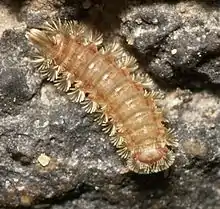Polyxenida
Polyxenida is an order of millipedes readily distinguished by a unique body plan consisting of a soft, non-calcified body ornamented with tufts of bristles – traits that have inspired the common names "bristly millipedes" or "pincushion millipedes". There are at least 86 species in four families worldwide, and are the only living members of the subclass Penicillata.
| Polyxenida | |
|---|---|
 | |
| Polyxenus lagurus | |
| Scientific classification | |
| Kingdom: | |
| Phylum: | |
| Subphylum: | |
| Class: | |
| Subclass: | Penicillata Latrielle, 1831 |
| Order: | Polyxenida Verhoeff, 1934 |
| Families | |
| |
| Synonyms | |
|
Subclass | |
Description
Polyxenida differ from other millipedes in having a soft, non-calcified exoskeleton, unique tufts of bristles or setae, fewer legs (no more than 17 pairs), and an absence of copulatory appendages in males. Individuals are small, not exceeding 7 millimeters (0.28 inches).
Defense
Bristly millipedes lack the chemical defenses and hard exoskeleton of other millipedes,[1] and instead employ a unique defense mechanism: the distinctive barbed bristles can easily detach and become entangled in the limbs and mouth-parts of predatory insects, effectively immobilizing them.[2]
Reproduction
Male Polyxenidans lack the modified sperm-transferring appendages (gonopods) found in most other millipede groups. As a result, sperm transfer is indirect: males deposit a spermatophore that is subsequently picked up by females.[3]
Many species reproduce asexually by way of parthenogenesis, wherein females lay eggs without mating and males are absent or rare.[4]
Classification

Polyxenida is the only living order of the subclass Penicillata, the basal subclass of millipedes. Penicillata is the sister group of all other living millipedes: the infraclasses Pentazonia and Helminthomorpha.[6][7]
In 2003 the Polyxenida contained 159 valid species and/or subspecies,[8] although at least eight new species have been described since 2010.[5][9][10]
- Superfamily Polyxenoidea Lucas, 1840
- Hypogexenidae Schubart, 1947
- Lophoproctidae Silvestri, 1897
- Polyxenidae Lucas, 1840
- Superfamily Synxenoidea Silvestri, 1923
- Synxenidae Silvestri, 1923
Fossil history
The earliest representatives of Polyxenida are found in Lebanese amber from the Early Cretaceous period.[11]
Some authors place the extinct orders Arthropleurida and Eoarthropleurida (each represented by a single genus) within the Penicillata as a sister group to Polyxenida.[12][13]
References
- Shelley, Rowland M. "The Myriapoda (Millipedes, Centipedes) Featuring the North American Fauna". Retrieved 12 October 2013.
- Eisner, T; Eisner, M; Deyrup, M (1996). "Millipede defense: use of detachable bristles to entangle ants". Proceedings of the National Academy of Sciences of the United States of America. 93 (20): 10848–51. Bibcode:1996PNAS...9310848E. doi:10.1073/pnas.93.20.10848. PMC 38244. PMID 8855269.
- Shelley, Rowland M. (1999). "Centipedes and Millipedes with Emphasis on North American Fauna". The Kansas School Naturalist. 45 (3): 1–16. Archived from the original on 2016-11-12. Retrieved 2013-10-12.
- Barnes, Robert D. (1987). "15. The myriapods". Invertebrate zoology (5th ed.). Philadelphia: Saunders College Pub. pp. 674–683.
- Nguyen Duy - Jacquemin, Monique; Uys, Charmaine; Geoffroy, Jean-Jacques (2011). "Two remarkable new species of Penicillata (Diplopoda, Polyxenida) from Table Mountain National Park (Cape Town, South Africa)". ZooKeys (156): 85–103. doi:10.3897/zookeys.156.2211. PMC 3253573. PMID 22303097.
- Sierwald, Petra; Bond, Jason E. (2007). "Current Status of the Myriapod Class Diplopoda (Millipedes): Taxonomic Diversity and Phylogeny". Annual Review of Entomology. 52 (1): 401–420. doi:10.1146/annurev.ento.52.111805.090210. PMID 17163800.
- Shear, W (2011). "Class Diplopoda de Blainville in Gervais, 1844. In: Zhang, Z.-Q.(ed.) Animal biodiversity : an outline of higher-level classification and survey of taxonomic richness" (PDF). Zootaxa. 3148: 159–164. doi:10.11646/zootaxa.3148.1.32.
- Nguyen Duy-Jacquemin, M.; J.-J. Geoffroy (2003). "A revised comprehensive checklist, relational database, and taxonomic system of reference for the bristly millipedes of the world (Diplopoda, Polyxenida)". African Invertebrates. 44 (1): 89–101.
- Short, Megan; Huynh, Cuong (2011). "The genus Unixenus Jones, 1944 (Diplopoda, Penicillata, Polyxenida) in Australia". ZooKeys (156): 105–122. doi:10.3897/zookeys.156.2168. PMC 3253574. PMID 22303098.
- Short, Megan; Huynh, Cuong (2013). "Four new species of Unixenus Jones, 1944 (Diplopoda, Penicillata, Polyxenida) from Australia". ZooKeys (278): 75–90. doi:10.3897/zookeys.278.4765. PMC 3677348. PMID 23794829.
- Duy-Jacquemin, MN; Azar, D (2004). "The oldest records of Polyxenida (Myriapoda, Diplopoda): New discoveries from the Cretaceous ambers of Lebanon and France". Geodiversitas. 26 (4): 631–641.
- Shear, William A.; Edgecombe, Gregory D. (2010). "The geological record and phylogeny of the Myriapoda". Arthropod Structure & Development. 39 (2–3): 174–190. doi:10.1016/j.asd.2009.11.002. PMID 19944188.
- Kraus, O; C. Brauckman (2003). "Fossil giants and surviving dwarfs. Arthropleurida and Pselaphognatha (Ateolocerata, Diplopoda): characters, phylogenetic relationships and construction". Verh. Naturwiss. Ver. Hamburg. 40 (5): 5–50.
External links
 Media related to Polyxenida at Wikimedia Commons
Media related to Polyxenida at Wikimedia Commons Data related to Polyxenida at Wikispecies
Data related to Polyxenida at Wikispecies- "Polyxenida" at the Encyclopedia of Life

- Photos of Polyxenida